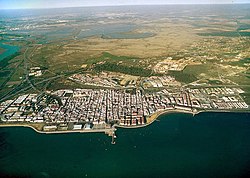
Cádiz is a city in Spain and the capital of the Province of Cádiz, in the autonomous community of Andalusia. It is located in the southwest of the Iberian Peninsula off the Atlantic Ocean separated from neighbouring San Fernando by a narrow isthmus.

Cádiz is a province of southern Spain, in the southwestern part of the autonomous community of Andalusia. It is the southernmost part of mainland Spain, as well as the southernmost part of continental Europe.
Algeciras is a city and a municipality of Spain belonging to the province of Cádiz, Andalusia. Located in the southern end of the Iberian Peninsula, near the Strait of Gibraltar, it is the largest city on the Bay of Gibraltar.

Jerez de la Frontera or simply Jerez, also cited in old English-language sources as Xeres, is a city and municipality in the province of Cádiz in the autonomous community of Andalusia, Spain. Located in southwestern Iberia, it lies on the Campiña de Jerez, an inland low-land plain crossed by the Guadalete river, midway the Atlantic Ocean, the Guadalquivir river and the western reaches of the Subbaetic System.

Marbella is a city and municipality in southern Spain, belonging to the province of Málaga in the autonomous community of Andalusia. It is part of the Costa del Sol and is the headquarters of the Association of Municipalities of the region; it is also the head of the judicial district that bears its name.

Sanlúcar de Barrameda, or simply Sanlúcar, is a city in the northwest of Cádiz province, part of the autonomous community of Andalucía in southern Spain. Sanlúcar is located on the left bank at the mouth of the Guadalquivir River opposite the Doñana National Park, 52 km from the provincial capital Cádiz and 119 km from Sevilla capital of the autonomous region Andalucía. Its population is 68,656 inhabitants.

The Political Constitution of the Spanish Monarchy, also known as the Constitution of Cádiz and as La Pepa, was the first Constitution of Spain and one of the earliest codified constitutions in world history. The Constitution was ratified on 19 March 1812 by the Cortes of Cádiz, the first Spanish legislature that included delegates from the entire nation and its possessions, including Spanish America and the Philippines. "It defined Spanish and Spanish American liberalism for the early 19th century."
Navantia is a Spanish state-owned shipbuilding dedicated to civil and military naval construction, the design of deep-tech systems and the manufacture of structures for the renewable energy sector, such as offshore wind or hydrogen.
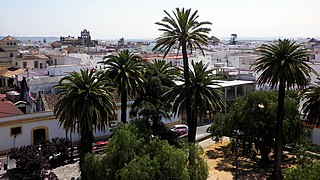
El Puerto de Santa María, locally known as El Puerto and historically in English as Port Saint Mary, is a municipality of Spain located on the banks of the Guadalete River in the province of Cádiz, Andalusia. As of 2016, the city has a population of c. 88,184, of which some 50,000 live in the urban center, and the remainder in the surrounding areas.

Chiclana de la Frontera is a town and municipality in southwest Spain, in the province of Cádiz, Andalucía, near the Gulf of Cádiz. It belongs to the association of municipalities of the Bay of Cádiz, the provincial capital of Cádiz, Jerez de la Frontera, San Fernando, El Puerto de Santa María, Puerto Real and Rota which form the third largest metropolitan area in Andalusia, behind Seville and Málaga, and the twelfth largest in Spain. It is located 20 kilometres south-east from Cádiz, and borders the municipalities of San Fernando and Puerto Real to the north and Conil de la Frontera to the south. In 1877, the municipality's population was 11,677; in 2012, it was 81,473. It has a surface area is 203 square kilometres (78 sq mi) and a population density of 401 inhabitants / km2. The average elevation is 11 metres (36 ft) above sea level. The economy depends largely upon modern industry, especially salt processing and tourism, and the municipality is known for its beaches such as the 6 kilometres (3.7 mi) long Playa de la Barrosa, hotels and golf courses in the resort of Novo Sancti Petri. The municipality contains the largest number of hotel beds in the Province of Cádiz and the Costa de la Luz. The town's newspaper, Viva Chiclana is distributed on Thursday mornings.
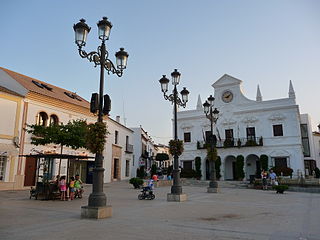
Cartaya is a Spanish locality and municipality in the Province of Huelva,. In 2010 it had 18,415 inhabitants. Its surface area is 226.4 km2 and has a density of 81.34 people per km2.

Isla del Trocadero is an island in the Bay of Cádiz, in Andalusia, Spain.
San Pedro Alcántara is a town in the municipality of Marbella, in Andalucía, Spain. It is a tourist destination of the Costa del Sol.
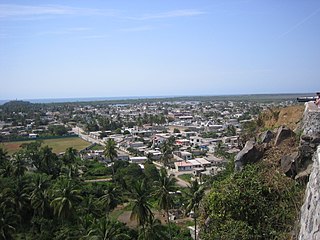
San Blas is both a municipality and municipal seat located on the Pacific coast of Mexico in Nayarit.

The Bay of Cádiz is a body of water in the province of Cádiz, Spain, adjacent to the southwestern coast of the Iberian Peninsula.
The Divisiones Regionales de Fútbol in the Community of Andalusia, are organized by the Federación Andaluza de Fútbol:

Cádiz is a Spanish appellation describing Vino de la Tierra wines whose terroir is located in the autonomous region of Andalusia. Vino de la Tierra is one step below the mainstream Denominación de Origen indication on the Spanish wine quality ladder.

The Constitution of 1812 Bridge, also known as La Pepa Bridge, is a new bridge across the Bay of Cadiz, linking Cadiz with Puerto Real in mainland Spain.

Arsenal de La Carraca, also Naval Station of La Carraca, is a naval shipyard and a naval base in San Fernando, Spain. It is a naval base for the construction and repair of ships, and the storage and distribution of arms and ammunition. The first military establishment of its kind to be created in Spain under the naval policy of Felipe V, it was developed by Patiño and the Marquis de la Ensenada. Though work on building the shipyard began in 1720, the formal decree issued by Fernando VI on October 3, 1752, accelerated its construction until it was completed in the late 18th century.
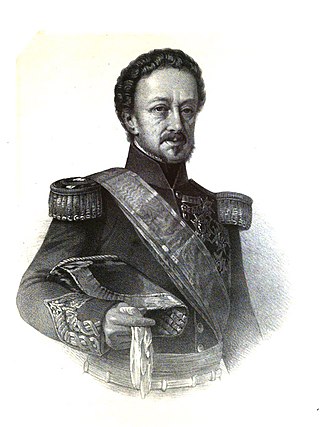
Pedro de Alcántara Téllez Girón y Alfonso-Pimentel, 2nd Prince of Anglona (1786–1851) was a Spanish military officer during the Peninsular War and a politician.
